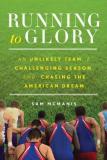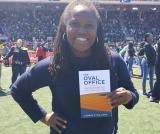Folders |
Lauryn Williams' Book, The Oval Office, Explains Why It's Important For Pro Track Athletes To Think Of Themselves As Business OwnersPublished by
Lauryn Williams' New Book A Resource For Pro Athletes By Doug Binder, DyeStat Editor At first glance, the new book by Lauryn Williams, “The Oval Office,” seems like it could be written only for the dozen or so track and field athletes making the jump to a big-time professional shoe contract. And for those select few – Grant Holloway, Sha’Carri Richardson, Grant Fisher, Mondo Duplantis, and others – the wisdom and advice about how to develop a professional mindset should be a necessary companion, if not mandatory. For the rest of us, Williams’ detailed explanation of how to ask questions of a prospective agent, how to manage money, how to travel efficiently, how to select a coach, how to grow a brand, how to manage the people who work for you, how to correctly file taxes, how to plan for a future outside the sport, and how to maintain balance – is a fascinating look at the mechanics that drive professional track and field. And yet, to start with, many young athletes who are eager to make the jump are at risk of missing this big-picture statement: “Track and Field is much more than showing up and competing. If you want to be successful at the professional level you have to embrace entrepreneurship. If you have no interest in running a business, then professional sports are not for you.” Williams is the perfect person to step through the process of becoming a professional. She has been through every aspect of this life. In 2004, she was in a similar spot to Richardson, the electrifying LSU freshman who turned pro earlier this month after a star turn in Austin, Texas. Williams won the NCAA 100-meter title for the University of Miami to conclude her junior year. She soon turned pro, made the U.S. Olympic team, and secured a silver medal at the Athens Games. “After some reflection, I came to the conclusion that it was best to forego the remainder of my NCAA eligibility and pursue my sports career. I was not old enough to drink or rent a car without paying an extra fee, but there I was making plans for a career as a professional athlete. And so it started.” HOW TO BUY A COPY: THE OVAL OFFICE: A Four-Time Olympian's Guide To Professional Track and Field Williams enjoyed a 10-year career, which concluded with a silver medal in the two-woman bobsled event at the Sochi Winter Games in 2014. She is the only female in U.S. Olympic history to stand on a podium at both the Summer and Winter Olympics. When it was over, she moved into a career as a certified financial planner. Chapter 6 of “The Oval Office,” is something of a business card. Williams shares personal finance guidance that applies not only to professional track athletes, but anyone. More than anything, Williams hopes her book helps young athletes avoid the pitfalls and mistakes that shorten careers and leave athletes unprepared for the future when their competition days are over. Too often, professional track athletes do not think of themselves as business owners. “I don’t think I did, initially,” Williams said. “I eventually realized something different from my peers. I realized I was a business owner. Everyone around you is enabling you. 'You just compete. Don’t you worry about it. We’ll take care of it.' There is so much they tell you to turn your brain off to, and that’s when you end up with a raw deal.” Every pro athlete needs to acquire smart, trustworthy people in order to navigate the business world. “Does your parent, your handler, know the information in this book?” Williams asks. “You can’t get business savvy overnight.” Fortunately, Williams offers real talk in The Oval Office with step-by-step instructions for how to manage business alongside workouts and competition. As a business owner, and a professional, it’s important to tell a compelling story using social media to build a following and attract opportunities. For Williams, that was never easy. “I think it’s important to build a following, but I am one of those people who hates (doing) social media,” she admitted. “Someone like Sanya (Richards-Ross), she is constantly posting pictures that are great quality. For me, personal is personal and I don’t want to put it out there for everybody’s opinions.” Still, Williams’ chapter on Branding explains how an effective use of social media can be crucial to sustaining and expanding an athlete's business opportunities. Asked which athletes under the age of 25 are operating the levers of social media effectively, Williams pauses. “I have not seen any that I love,” she said. “I follow all the young athletes, but who’s doing it where you’re telling your story, and doing it in a way to draw people to you? I have not seen anybody that I love as of late. Some are doing terrible, and some just don’t understand how to tell their story.” Williams’ current task is to get her information into the hands of the select few who really need it. “It takes a while to get (book sales) going,” she said. “I think athletes need a resource, and the time is now. It’s not meant to be a New York Times best-seller, but I think this book is a valuable resource.” |



